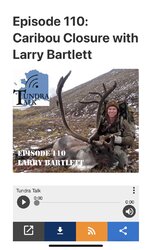Another great question. I can't answer for the state vs fed argument because apparently the Sturgeon Vs Frost case will "only be acknowledged" by the local jurisdiction, implying the feds still plan to assert their perceived power below mean high water mark as they interpret the laws for a specific region or river system they manage. Meaning, on one hand Gov Dunleavy has asserted Alaska rights to all lands below mean high water to include the streambed on navigable waterways in the state. On the other hand the Feds claim rivers in their respective public lands are federally patrolled and enforced. When both sides have a hand on each of your shoulders it will be your responsibility to act and hunt legally by state rules and federal rules, and then claim your right to hunt below mean highwater mark on any stream that can be navigated with 1300-lbs or more. 4-6" depth is what this law means to me because I have created rafts that do it and have proven viable commerce for 25 years on streams with no names considered "non-navigable" by the feds. I would love to challenge the feds to compare their list of navigable waterways to my own. That to say, another gray area that has yet to be determined between state and federal land managers. Travel and hunt at your own risk, which what makes Alaska so ******* great.
If though, for example, you're camped below mean high water on federal lands within the closures and your harvest stumbles and dies above mean highwater debris...you will have to make a decision to retrieve that animal and trespass into closed terrain. That's a problem, legally, but not ethically. In Alaska you must recover and salvage all edible meat from big game, even that means dragging that critter back onto state land to finish your legal business. Therefore, you might have to battle your case in court if that scenario was realized and you were caught "trespassing for hunting" on closed federal land. It's still a gray area, and I believe this gray area might also eventually be challenged by "our user group" in ways that forces factual requirements by the FSB when ruling FOR closing public lands in Alaska instead of basing them on hunches of begrudged subsistence users. I simply won't stand for it anymore. It's wrong and prejudice against non-local hunters and public land owners.
Shot placement and confidence in state sovereignty is all I need. High water line is often 50-100 ft or more beyond the shoreline, which has always been enough room to safely and ethically dispatch caribou and moose while camped near flowing water.
As for the question of user conflict between local boaters and planes landing below mean highwater in proposed closed areas: Not plausible due to the standing controlled use zone upstream along the Noatak River, which extends farther upstream than locals are known to travel except on high water years during migrations, which is rare indeed. These control use boundaries prevent planes from landing for supporting hunting activities, so pilots select areas for p/us outside of the CUAs and far from local subsistence activities.
You'll hear Natives claim conflict is greater on the Squirrel river and Noatak, but that's not true. The squirrel has always had reasonable high guide presence in certain pockets, and Natives have co-existed with this rule for forty plus years. That river system is heavily patrolled by LEOs, and the only time issues come up for realzies is when local subsistence users get drunk and decide to create conflict themselves by traveling into guided territory with angst and ill regard for non-locals. The Noatak argument is a dead one because of the always increasing CUA along its course.


